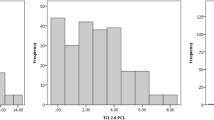Abstract
There have been large, recent increases in the number of children and families migrating from Central America to the U.S. to escape regional cartel and gang violence. The rate of trauma exposure in recently immigrated youth from Central America is therefore alarmingly high and current trauma symptom measures have not been evaluated for use in this population. The broad goal of this study was to report on the psychometric properties of one such measure in two studies of recently immigrated youth. Data collected included self-report of recent immigrants from Central America attending public high school in the Southwestern U.S. and caregiver-report from a sample of Central American immigrants who arrived in the U.S. within the last 24 hours and reported on trauma symptoms in their children. Aims included providing descriptive data and examining inter-item correlations and factor structure. Results indicated trauma symptoms far exceeding published cutoff levels as well as adequate internal consistency and inter-item correlations. Findings of the current studies suggest a pressing need for the assessment of trauma symptoms among recently immigrated youth from Central America, in which the rates of exposure and symptoms were striking.
Similar content being viewed by others
References
Cardoso, J. B. (2018). Running to stand still: trauma symptoms, coping strategies, and substance use behaviors in unaccompanied migrant youth. Children and Youth Services Review, 92, 143–152.
Clark, L. A., & Watson, D. (1995). Constructing validity: Basic issues in objective scale development. Psychological Assessment, 7, 309–319.
Foa, E. B., Johnson, K. M., Feeny, N. C., & Treadwell, K. R. (2001). The Child PTSD Symptom Scale: A preliminary examination of its psychometric properties. Journal of Clinical Child Psychology, 30(3), 376–384.
Gudiño, O. G., & Rindlaub, L. A. (2014). Psychometric properties of the Child PTSD Symptom Scale in Latino children. Journal of Traumatic Stress, 27(1), 27–34.
Hinton, D. E., & Lewis-Ferńandez, R. (2011). The cross-cultural validity of post-traumatic stress disorder: Implications for DSM-5. Depression and Anxiety, 28, 783–801. https://doi.org/10.1002/da.20753.
Hiskey, J. T., Córdova, A., Orces, D., & Malone, M. F. (2016). Understanding the Central American refugee crisis. Washington, DC: American Immigration Council.
Hoyt, T., & Yeater, E. A. (2010). Comparison of posttraumatic stress disorder symptom structure models in Hispanic and White college students. Psychological Trauma, 2, 19–30. https://doi.org/10.1037/a0018745.
Jaycox, L. H., Stein, B. D., Kataoka, S. H., Wong, M., Fink, A., Escudero, P., & Zaragoza, C. (2002). Violence exposure, posttraumatic stress disorder, and depressive symptoms among recent immigrant schoolchildren. Journal Of The American Academy Of Child & Adolescent Psychiatry, 41(9), 1104–1110. https://doi.org/10.1097/00004583-200209000-00011.
Kassam‐Adams, N., Gold, J. I., Montaño, Z., Kohser, K. L., Cuadra, A., Muñoz, C., & Armstrong, F. D. (2013). Development and psychometric evaluation of child acute stress measures in Spanish and English. Journal of Traumatic Stress, 26(1), 19–27.
Kataoka, S. H., Stein, B. D., Jaycox, L. H., Wong, M., Escudero, P., Tu, W., ... & Fink, A. (2003). A school-based mental health program for traumatized Latino immigrant children. Journal of the American Academy of Child and Adolescent Psychiatry, 42(3), 311–318..
Kataoka, S., Langley, A., Stein, B., Jaycox, L., Zhang, L., Sanchez, N., & Wong, M. (2009). Violence exposure and PTSD: The role of English language fluency in Latino youth. Journal of Child and Family Studies, 18(3), 334–341.
Marshall, G. N. (2004). Posttraumatic stress disorder symptom checklist: factor structure and English-Spanish measurement invariance. Journal Of Traumatic Stress, 17(3), 223–230. https://doi.org/10.1023/B:JOTS.0000029265.56982.86.
Nixon, R. D., Meiser-Stedman, R., Dalgleish, T., Yule, W., Clark, D. M., Perrin, S., & Smith, P. (2013). The Child PTSD Symptom Scale: an update and replication of its psychometric properties. Psychological Assessment, 25(3), 1025.
Simms, L. J., Watson, D., & Doebbeling, B. N. (2002). Confirmatory factor analyses of posttraumatic stress symptoms in deployed and nondeployed veterans of the Gulf War. Journal of Abnormal Psychology, 111, 637–647. https://doi.org/10.1037/0021-843X.111.4.637.
United Nations Office on Drugs and Crime (2013). Global study on homicide 2013: trends, contexts, data. Vienna: UNODC. https://www.unodc.org/gsh/ Accessed on September 13, 2018.
United States Conference of Catholic Bishops (2014). Testimony of Most Reverend Mark Seitz. http://www.usccb.org/about/migration-and-refugee-services/upload/2014-MRS-Annual-Report.pdf Accessed September 13, 2018.
United States Customs and Border Patrol (2016) Southwest Border Sectors. https://www.cbp.gov/.
Author Contributions
AV: collaborated with the design and execution of both studies, conducted the data analyses, and wrote the paper. AM: collaborated with the design of study 2, executed data collection for study 2, and participated in editing of the final manuscript.
Funding
University of Texas System, Office of Global Engagement, Co-Is: Mercado & Venta. SHSU Center for Enhancing Undergraduate Research Experiences and Creative Activities, PI: Venta. SHSU Enhancement Research Grant, PI: Venta.
Author information
Authors and Affiliations
Corresponding author
Ethics declarations
Ethical Approval
All procedures performed in studies involving human participants were in accordance with the ethical standards of the institutional review boards at Sam Houston State University and the University of Texas- Rio Grande Valley as well as with the 1964 Helsinki declaration and its later amendments or comparable ethical standards.
Informed Consent
Informed consent was obtained from all individual participants included in the study.
Conflict of Interest
Author AV has received research grants from SHSU. Authors AV and AM have received a research grant from the UT System.
Rights and permissions
About this article
Cite this article
Venta, A.C., Mercado, A. Trauma Screening in Recently Immigrated Youth: Data from Two Spanish-Speaking Samples. J Child Fam Stud 28, 84–90 (2019). https://doi.org/10.1007/s10826-018-1252-8
Published:
Issue Date:
DOI: https://doi.org/10.1007/s10826-018-1252-8



